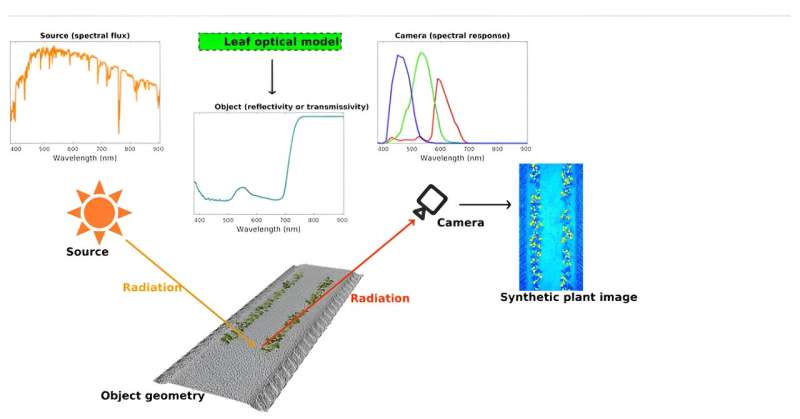This article has been reviewed according to Science X's editorial process and policies. Editors have highlighted the following attributes while ensuring the content's credibility:
fact-checked
trusted source
proofread
New radiative transfer modeling framework enhances deep learning for plant phenotyping

A research team has developed a radiative transfer modeling framework using Helios 3D plant modeling software to simulate RGB, multi-/hyperspectral, thermal, and depth camera images with fully resolved reference labels. This innovative method markedly diminishes the necessity for labor-intensive, manually annotated datasets.
The framework's capacity to generate high-quality synthetic images enables efficient training of deep learning models for high-throughput plant phenotyping, thereby enhancing crop trait analysis and providing a instrument tool for advancing agricultural research and remote sensing applications.
The integration of remote and proximal sensing methodologies facilitates the high-throughput monitoring of plant systems, providing comprehensive insights into plant function. Advances in these technologies have led to abundant high-resolution images, but challenges remain in linking this data to actionable plant traits. The current methods are inadequate for the labor-intensive data annotation and multimodal data alignment that are required.
A study published in Plant Phenomics on 30 May 2024, aims to address these challenges by developing a novel 3D radiative transfer modeling framework.
This research verified a radiative transfer model using a variety of SKILL scores to evaluate its accuracy in simulating the radiation absorbed by objects and reflected radiation fluxes. The SKILL scores for different tests (brfpp_uc_sgl, brfpp_co_sgl, brfop, and fabs) were 98.00, 92.65, 97.52, and 99.98, respectively, demonstrating the model's high precision.
Moreover , the R2 values for camera calibration ranged from 0.864 to 0.930, indicating effective distortion recovery and color calibration. Synthetic images generated using the model, including RGB, NIR, and thermal images, showed high visual similarity to real images, thereby confirming the model's ability to produce high-quality, annotated plant images. These findings validate the model's efficacy in simulating intricate scenes and establish it as a robust instrument for high-throughput plant phenotyping and machine learning model training.
The study's lead researcher, Tong Lei, asserts that Helios offers a simulated environment that enables the generation of 3D geometric models of plants and soil with random variation, as well as the specification or simulation of their properties and functions. This approach diverges from traditional computer graphics rendering, as it explicitly models the physics of radiation transfer, thereby establishing a crucial link to the underlying biophysical processes of the plant.
In summary, this study introduces a radiative transfer modeling framework using Helios 3D software to simulate plant images, including RGB, multispectral, thermal, and depth images, with detailed annotations. The framework reduces the need for manual data collection and improves deep learning model training for plant phenotyping.
Future developments will enhance model flexibility and incorporate more complex processes, advancing high-throughput phenotyping and agricultural research by providing efficient analysis of plant traits and physiological states.
More information: Tong Lei et al, Simulation of Automatically Annotated Visible and Multi-/Hyperspectral Images Using the Helios 3D Plant and Radiative Transfer Modeling Framework, Plant Phenomics (2024). DOI: 10.34133/plantphenomics.0189
Provided by NanJing Agricultural University



















